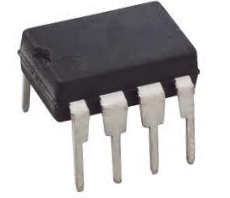Op Amp Specifications
Slew Rate

The Slew Rate of an op amp is the maximum rate (speed) at which the op amp can produce output voltage.
Just going back to basics, op amps are devices that take an input voltage and produce an output voltage. Often times, it amplifies to this voltage to produce an amplified voltage at the output. But sometimes op amps simply function as voltage followers and act as buffers, where there is no gain. Regardless of the reason for which the op amp is used, the slew rate is how fast the op amp can produce output voltage.
The slew rate of an op amp is usually expressed in volts per microsecond. Thus, from this specification, we can tell how many volts in amplitude an op amp can produce per unit time, which is usually in microseconds. Slew rates range from a fraction of a volt to several hundred volts per microsecond; however, a typical and common value is about 10 V/µs.
Op amps with the highest slew rates are the best ones for use at high frequencies. This is because they can produce output voltage quicker, or rather produce more output voltage per microsecond. Higher-frequency signals have quicker oscillation than lower-frequency signals. Therefore, if dealing with high-frequency signals, the op amp must be able to produce voltage at a quick rate. This is why op amps outputting higher-frequency signals must have high slew rates. When an op amp is amplifying a high frequency sinusoidal signal, the slew rate can be exceeded. In cases, where the slew rate is exceeded, the output voltage fails to keep up with the rapidly rising and falling input voltage. The output waveform is then distorted into a triangular waveform and the amplitude is greatly attenuated.
Low-frequency signals, especially with moderately low amplitudes, do not need to have op amps with high slew rates.
An example of an op amp is the LM741; the LM741 has a slew rate of 0.5V/µs. This is relatively low speed for an op amp.
Some high-speed op amps such as the LH0063C have a slew rate of 6000V/µs. This is suitable for very high-speed applications such as AC signals in the megahertz frequency.
But back to the LM741, it has an slew rate of 0.5V/µs. This means it can output 0.5V each microsecond.
The microseconds time range relates to frequencies in the megahertz.
However, they are not direct. For example, the LM741 can output 0.5V/µs, but this does not mean it can output 0.5V for a 1MHz frequency. It isn't a direct relationship like that.
Instead, the formula for the slew rate of an op amp is, slew rate= 2πfV, where f is the frequency and V is the voltage.
Based on this formula, we can calculate either the slew rate, the frequency of the signal, or the voltage of the signal.
We'll start with the slew rate. The slew rate equals, 2πfV. If we want to output a 10V signal with a frequency of 50KHz, we plug these values into the formula, slew rate= 2πfV= 2(3.14)(50,000Hz)(10V) = 3,140,000. This value is the slew rate expressed in volts per second (V/S). Since the slew rate is normally expressed in volts per microsecond (V/µS), ( we divide this value by 1,000,000 and get 3.14V/µs (3,140,000/1,000,000= 3.14). This is how slew rate is calculated. This value represents the minimum slew rate that should be used if a person wants that voltage output at that frequency. Therefore, a designer should look for an op amp with a slew rate of that value or higher to incorporate into a circuit.
Besides simply the slew rate, the formula can calculate the maximum frequency that should be used with an op amp given the amount of voltage desired to be output. This is if we want to calculate what the maximum frequency is that an op amp can work with given a voltage value. Say we want to see what's the highest frequency an op amp can work with for a 16V output signal. Before we plug the values in, realize that if we're working with an LM741 op amp which has a slew rate of 0.5V/µs, it would be easier to convert the slew rate to seconds instead of having the microseconds. This allows us to deal directly with hertz. It's, therefore, more straightforward. So we convert 0.5V/µs to 500,000V/s to make the calculation more straightfoward. Plugging these values into the formula, we get, slew rate= 2πfV= 500,000/µs= 2(3.14)f(16V)= 4,976Hz. So this is highest frequency the op amp can work with when outputting 16V.
The thing we can calculate from the formula is the maximum voltage that can output based on a given frequency. Say we want to know what's the maximum voltage that can output for 15KHz. Using the formula, we plug in the values, slew rate= 2πfV= 2(3.14)(15,000Hz)f= 5.3V. So the maximum voltage that can be ouput is 5.3V for a 15KHz for an op amp that has a slew rate of 0.5V/µs.
To see our calculator on calculating the slew rate, see the
slew rate calculator. It allows you to calculate the minimum slew rate needed for an op amp, the maximum voltage for a given frequency, or the maximum frequency for a given voltage.